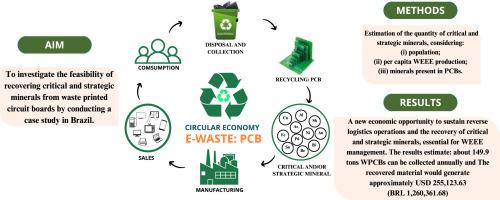管理和回收电子废物中的关键和战略原材料:以印刷电路板为重点的巴西案例研究
IF 5.4
Q2 ENGINEERING, ENVIRONMENTAL
引用次数: 0
摘要
技术进步和新产品开发增加了对矿物原材料的需求,尤其是对清洁技术的需求。由于供应风险和经济重要性,一些材料被归类为 "关键 "或 "战略 "材料,人们越来越关注其稀缺性和供应减少的问题。地缘政治和环境因素,尤其是采矿,是影响这些材料价格和供应的关键因素。回收利用可提供二次原材料,支持循环经济,但在这一领域的贡献仍然很小。在废弃电气和电子设备(电子垃圾)中发现了许多重要的战略矿物。然而,像巴西这样的国家在电子废弃物回收利用方面面临重重障碍,例如需要逆向物流、非法回收市场、数据匮乏以及完全回收利用的技术有限。巴西市政当局缺乏有关电子废物生产的原始数据,这阻碍了有效的废物管理政策。本研究评估了废弃印刷电路板(WPCB)中关键和战略原材料的潜在回收量,有助于估算巴西的电子垃圾量。研究使用了一个中等城市(代表巴西大多数城市)的原始数据,收集了巴西家庭中各种日常电子产品的信息。结果估计,每年可收集约 149.9 吨 WPCB,并对其材料进行处理和回收。回收的材料将产生约 255 123.63 美元(1 260 361.68 巴西雷亚尔)的收入,约占每年城市清洁成本的 3.24%。总之,该研究表明,从 WPCB 中回收材料可为固体废物管理提供资金支持,从而加强了未来对逆向物流和回收设施进行投资的理由。本文章由计算机程序翻译,如有差异,请以英文原文为准。

Management and recovery of critical and strategic raw materials from E-Waste: A case study in Brazil with a focus on printed circuit boards
Technological advances and new product development have increased demand for mineral raw materials, especially for clean technologies. Some materials are classified as 'critical' or 'strategic' due to supply risk and economic importance, with growing concerns about scarcity and supply reduction. Geopolitical and environmental aspects, particularly mining, are key factors affecting the price and supply of these materials. Recycling provides secondary raw materials and supports a circular economy, but its contribution remains small in this sector. Many critical and strategic minerals are found in waste electrical and electronic equipment (e-waste). However, countries like Brazil face obstacles in e-waste recycling, such as the need for reverse logistics, an illegal recycling market, data scarcity, and limited technology for complete recycling. The lack of primary data on e-waste production in Brazilian municipalities hampers effective waste management policies. This study evaluates the potential recovery of critical and strategic raw materials in waste printed circuit boards (WPCBs), contributing to e-waste estimates in Brazil. Using primary data from a medium-sized city, representative of most Brazilian cities, the research collected information on various everyday electronic products in Brazilian households. The results estimate that about 149.9 t WPCBs can be collected annually, with their materials processed and recovered. The recovered material would generate approximately USD 255,123.63 (BRL 1,260,361.68) in revenue, representing about 3.24 % of the annual municipal urban cleaning costs. Overall, the study demonstrates that material recovery from WPCBs can provide financial support for solid waste management, reinforcing the case for future investments in reverse logistics and recycling facilities.
求助全文
通过发布文献求助,成功后即可免费获取论文全文。
去求助
来源期刊

Journal of hazardous materials advances
Environmental Engineering
CiteScore
4.80
自引率
0.00%
发文量
0
审稿时长
50 days
 求助内容:
求助内容: 应助结果提醒方式:
应助结果提醒方式:


